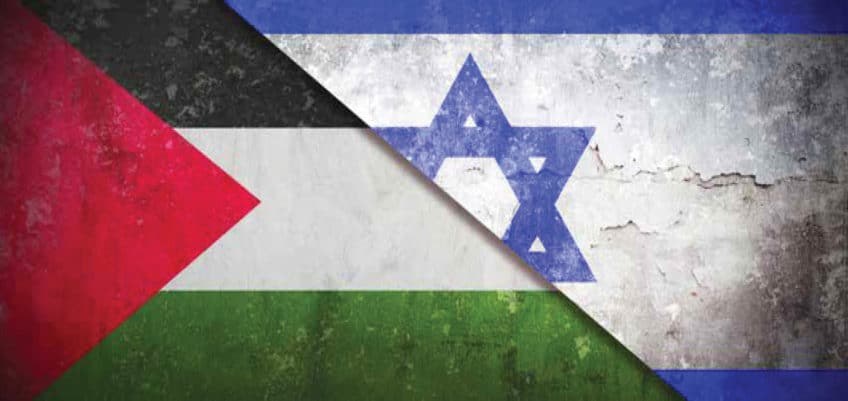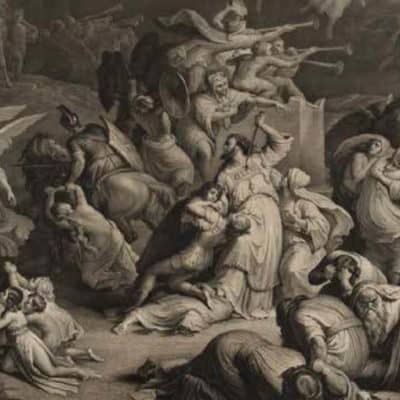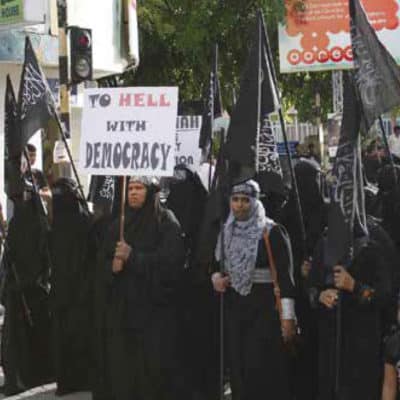The two-state solution has been the subject of international debate for longer than most of us have been alive. Palestine, a sovereign nation for the Palestinians, is the answer, supporters claim, to Arab-Israeli hostilities that have long vexed the region and the world. Israel would shrink to its pre-1967 borders (at least), Jerusalem would be split into East and West, and peace would break out across the land. Does anyone really believe that to be true? Can we reasonably expect the conflicts so rampant in this area’s past to be resolved in the future, and what does history tell us about the legitimacy and viability of this two-state solution?
The region itself has been referred to as Palestine at many points in history. Its ancient history can be found in the Bible as the majority of the events described take place in and around this area. It is part of the land promised by God to Abraham, Issac and Jacob, whose name was changed to Israel. Palestina is mentioned in the song of Moses (Exodus 15) after the Israelites had crossed through the Red Sea and also by the prophet Isaiah. Joel references Palestine as well.
Both Palestina and Palestine are translated from the same Hebrew word that is rendered Philistia in Psalms 60, 87 and 108. This is the land of the Philistines, well known antagonists from the early history of the nation of Israel. Philistim, their progenitor, can be found in the genealogies listed in Genesis 10 as the son of Casluhim, who is the son of Mizraim, who is the son of Ham. Ham was also the father of Canaan whose name was more often applied to the land God gave to Israel, as it is called in Genesis 12 when God promised Abraham “unto thy seed will I give this land.”
The Philistines are mentioned hundreds of times in the scriptures. They loom large in the book of Judges as well as the early kingdom period during the reigns of Saul and David. One of the most famous stories in the Bible is the fight between David and Goliath, who was called the champion of the Philistines. Goliath was from Gath, the chief city of one of the five kings of the Philistines, all of whom were equal and sovereign in their own territory. Their five cities were Gaza, Ashkelon, Ashdod, Gath and Ekron. All five were in the coastal area west of Jerusalem, and each was independently governed.
While they would eventually be conquered and disappear from history, the name Palestine remains and has been applied to a much larger territory than the five kings ever occupied. In addition to scriptural references, versions of the name appear on Egyptian and Assyrian inscriptions. The first time Palestine was used to refer to the entire region between Egypt and Phoenicia was in the fifth century BC by the Greek writer Herodotus. It was subsequently used by many well known ancient writers such as Aristotle, Ovid, Pliny the Elder and Josephus among others. Rome created of the province “Syria Palestina” in the second century AD out of what had previously been Judaea and Galilee. This was the first use of the name as an official designation.
This area of land, this crossroads of the ancient world, has been conquered, lost and reconquered so many times it passes imagination. Innumerable wars and conflicts have turned this promised land, once an earthly paradise flowing with milk and honey, into a desolate desert in desperate need of rehabilitation. Control of this land has changed hands many, many times. While convenient for those who wish to endow the push for statehood with the authority of antiquity, the modern Palestinians did not descend from the ancient Philistines. They do occupy the same land and consequently bear the same name. Their attitude towards Israel is also quite similar. That however, is where the similarities end.
As mentioned earlier, the Philistines were a Hamitic people. Those who now call themselves Palestinians are undeniably Arab and consequently Semitic. On this issue at least authorities agree and history proves the idea of a prior claim on the land to be fallacious. On the other hand, theories about when and how the modern concept of “Palestinian” as a national identity, dispossessed of land and self-government, came into being are rife with disagreement. The term Palestinian has traditionally been used in a regional rather than national connotation.
As was mentioned before Syria Palestina was a Roman province in the period following the writings of the New Testament, and after Titus destroyed Jerusalem. The area was briefly under the control of the Palmyrene Empire before again falling into the hands of Rome. The Samaritans in the region enjoyed small amounts of self-government as the power center moved from Rome in the West to the new capitol city of Constantinople in the East. They revolted and were put down many times as the Empire fluctuated. For a short time they were ruled by the Sasanian Empire, the last Persian dynasty before the rise of Islam, but reverted to Rome in the period historians now refer to as Byzantine.
Approaching the middle of the seventh century AD the land was conquered by Arabs who had recently converted to Islam. The Dome of the Rock was built in AD 691 on top of the Temple Mount. Control passed between various Caliphs as well as being taken and lost by several of the Crusades. The Mamluk Sultans of Egypt exercised control from 1260 until being conquered by the Ottomans. After centuries of dispute and armed conflict, the Ottoman Empire began ruling the area in 1516 and would continue to do so for the next four hundred years with relatively brief periods of unrest.
Throughout these many vacillations of power the Jewish presence in the land has been constant. They fought along side various factions, including Muslim rulers against the Crusaders, and even exercised autonomy during several of their own revolts. Their connection to the land is ancient and very well documented in history as well as the Bible and even the Koran.
The earliest estimates place the emergence of a national Palestinian identity around 1834 in an event called the Peasants’ Revolt. An Egyptian vassal of the Ottoman Empire Muhammad Ali and his son Ibrahim Pasha successfully broke away from the Ottomans and conquered the land from Egypt as far north as Damascus. They demanded the conscription of one out of every five Muslim males of fighting age. This, along with the loss of other traditional privileges, infuriated the population who widely considered conscription a death sentence.
The Arabs in Palestine essentially rebelled against a rebellion. Fighting broke out in many districts and the rebels took and plundered Jerusalem. They looted the shops of the Christians, Jews and eventually Muslims as well before turning to the homes of Christians and the state-owned supply warehouses and granaries. This is ironic considering they were ostensibly freeing the city from an unwanted occupying force. Muhammad Ali quickly reasserted his control over the region and the rebellion lasted only from May to August. Critics of the idea that this event served to forge any national Palestinian identity point out that the goal of the rebellion was never independence but a restoration of Ottoman control, which did occur some years later.
The Ottoman period continued all the way into the twentieth century, when the Empire allied itself with the Central Powers in World War I which included Germany, Austria-Hungary and Bulgaria. After their defeat the League of Nations concocted the Mandate System to administer different portions of land previously controlled by the now defunct Empires. These lands were not considered annexed. The nation granted the mandate was forbidden to raise an army or construct fortifications in the territory and were required to submit an annual report to the League. These mandates were divided into three classes based on their level of development. Mandatory Palestine was granted to the United Kingdom in 1922. All Class A Mandates were considered to “… have reached a stage of development where their existence as independent nations can be provisionally recognized subject to the rendering of administrative advice and assistance by a Mandatory until such time as they are able to stand alone.”
In 1917 U.K. Foreign Secretary Arthur Balfour issued a statement that bears his name, the Balfour Declaration, which stated, “His Majesty’s Government view with favour the establishment in Palestine of a national home for the Jewish people, and will use their best endeavours to facilitate the achievement of this object, it being clearly understood that nothing shall be done which may prejudice the civil and religious rights of existing non-Jewish communities in Palestine, or the rights and political status enjoyed by Jews in any other country.” With significant Jewish populations in many of their own territories and the war still under way, Germany and the Ottoman Empire were quick to respond by giving the Jews assurances of their own. This was, of course, known at the time the United Kingdom was granted the Mandate and was viewed favorably by many nations.
Persecution of the Jews has not been uncommon in history. While still controlled by the Ottomans the land received large numbers of Jews fleeing pogroms in Eastern Europe in 1881. A further 40,000 Jews arrived as a result of the Kishinev pogroms between 1904 and 1914. The British Mandate lasted from 1922 until 1948. These years encompass the rise of antisemitism, Naziism and World War II, and throughout them hundreds of thousands of Jews poured in from Europe. Limits were placed on immigration which became a source of contention for Jews and Arabs alike, both of whom found themselves continually at odds with their British overseers. Even Holocaust survivors who arrived after quotas had been met were placed in internment camps, such as those in Atlit and on Cypress. Some say it is during these years that the idea of being distinctly Palestinian crystallized into the push for an independent state of Palestine, though whether or not it was simply a response to the looming creation of Israel is the subject of much contentious debate.
In 1947 the British announced their desire to withdraw from Palestine, having been unable to solve the problems of self government for the region in ways satisfying to both Jews and Arabs. The question went before the United Nations, successor of the League of Nations, which appointed a special commission on Palestine to investigate possible solutions. They placed before the general assembly a plan of partition with economic union, proposing the simultaneous creation of Israel and Palestine with Jerusalem as an internationally administered city. Resolution 181 was adopted with with 72% of voting nations for and 28% against, with an additional ten nations abstaining and one absent. Most Jews rejoiced at the outcome but the majority of Arabs rejected it. Representatives from many Arab states walked out of the assembly, declaring they would not be bound by the decision. This certainly stands in stark contrast with the idea, still prevalent today, that a Palestinian state is what is necessary to achieve peace. The attempt at Palestinian statehood in 1948 proved the exact opposite.
The day after the UN resolution was announced violence erupted throughout the area. The United States withdrew its support for the partition plan and the United Kingdom began advocating for the annexation of the West Bank by Jordan, which had agreed to refrain from attacking Israel. Jewish military organizations became more organized as the Arab League formed the Arab Liberation Army and deployed its forces around the country. The leader of the Arab League told a reporter in reference to the Jews, “We will sweep them into the sea” and the President of Syria is quoted as saying “we shall eradicate Zionism.”
On May 14, 1948 the State of Israel was declared established and British forces withdrew at midnight. The very next day the armies of Egypt, Syria, Jordan and Iraq along with contingents from other nations attacked Israel. In addition to occupying the Arab areas they began attacking Jewish settlements, the Jews feared a repeat of the Holocaust that many of them had just survived.
While initially on the defensive, Israeli forces quickly turned the tide against their attackers. Conscription had become obligatory for men and women and all citizens received combat training. After the British withdrawal Israel began purchasing armaments which allowed them not only to hold their ground but drive the combined Arab forces back, putting them in control of more territory including the Western half of Jerusalem. Atrocities were not lacking on either side of the conflict. Many Arabs fled during the period of unrest before the actual war began and more were displaced by combat. During the year of fighting Israel passed measures declaring land occupied during the war officially annexed. After the ceasefire was negotiated Jordan annexed the West Bank and Egypt occupied the Gaza Strip. Those living in the West Bank became Jordanian citizens.
In May of 1949 Israel was accepted into the United Nations. Palestinians in the Gaza Strip remained under the protection of the Egyptian military. The All-Palestine Government was formed but was merely symbolic, having no executive power. The Fedayeen, Arabic for “those who sacrifice themselves,” emerged from among the population of Gaza and for decades infiltrated the various borders of Israel to attack both civilian and military targets. Considered alternately freedom fighters or terrorists, their attacks elicited responses from the Israeli military which were then used to justify further attacks. A Palestinian state, so recently offered under peaceful circumstances, would continue to be demanded and fought for in a manner making the reconciliation of Jewish and Arab viewpoints increasingly unlikely.
The Palestinian Liberation Organization was founded in 1964 with its stated goal “the liberation of Palestine” through armed struggle. Its operations often targeted Israeli civilians and led to many considering it a terrorist organization. The PLO focused on Palestinian statehood, not alongside Israel but encompassing all the land of the former Mandate, as well as the extermination of Zionism and “cleansing” the land of Jews. While undoubtedly unsettling, the language used could hardly have been surprising. World War II was less than twenty years past. The meetings of Adolf Hitler with the Grand Mufti of Jerusalem and their ideological agreement were probably part of the consciousness of all Jews of that day. The PLO continued through the following decades of conflict until it became the Palestinian National Authority still extant today.
The next major development came in 1967 with what is known as the Six-Day War. In response to the build-up of Egyptian forces along Israel’s southern border, a preemptive strike was ordered against Egyptian airfields. Simultaneously, an Israeli ground attack was launched across the southern border. Both were unexpectedly successful; the Egyptian air force was almost completely destroyed and Israel took all of Sinai. In the initial confusion Egyptian President Nasser intentionally deceived leaders of both Jordan and Syria, telling them Egypt had won a crushing victory against Israel’s army and convincing them to attack Israel. Even after Jordanian and Israeli forces began exchanging fire in Jerusalem, Prime Minister Eshkol contacted King Hussein of Jordan, promising not to initiate action if Jordan would stay out of the war to which he replied it was too late, “the die was cast.”
Israel was again victorious, defeating the combined forces of Egypt, Jordan, Syria, Iraq and Lebanon, and taking control of the Gaza Strip, Sinai Peninsula, Golan Heights (from which Israeli settlements had often received mortar fire through the years), East Jerusalem and the West Bank. This is the event most pointed to as crystallizing a Palestinian national identity. Blame for the war flew in all directions with the legitimacy of Israel’s preemptive strike on what was obviously a build up for invasion the topic of fierce debate. In response to this humiliating defeat, neither the first nor the last of its kind, Jews in Arab nations were persecuted and exiled from their homes. Many sought refuge in Israel. The Arab League summit in September of 1967 issued the Khartoum Resolution after the war. It contained the “three no’s”: No peace with Israel, no recognition of Israel, and no negotiation with Israel. Limited hostilities continued for the next few years with no real change in territory controlled.
War broke out again in 1973 when Egypt and Syria coordinated attacks on Israel with the help of expeditionary forces from Iraq, Jordan, Saudi Arabia, Morocco, Algeria and Cuba. They attacked through Sinai as well as the Golan Heights on Yom Kippur, by which name the war is known. Yom Kippur, the annual Holy Day of Atonement is a day of fasting and the Jews would have had neither food nor water since the previous sunset. Though initially pushed back, the Israeli army went on the offensive after reinforcement by reserve troops. They routed the coalition of Arab nations, surrounded the city of Suez in Egypt and shelled Damascus before a cease fire was successfully negotiated after less than twenty days of fighting. Israel eventually made peace with Egypt following the Camp David Accords of 1978 and withdrew from Sinai in 1982. Jordan officially ceded control of the West Bank in 1988.
Also in 1988 the Palestinian Liberation Organization declared independence for Palestine with itself as government-in-exile in Algiers. This and other events sparked a new period of rebellion against Israel. Attacks and retaliations created an extremely tense situation and hundreds of Palestinians were publicly executed by other Palestinians for allegedly conspiring with Israel. Back in 1974 the United Nations adopted Resolutions 3236 and 3237 recognizing the right of the Palestinian people to self-determination, national independence, sovereignty, acknowledging the PLO as the representative of the Palestinian people to the United Nations and granting them non-state observer status.
Since that time Palestine has been considered a state de jure, meaning that while it is a nation in the sense that it is recognized by other nations it lacks sovereignty and exists more in theory than reality. Statements of its recognition indicate the 1967 borders contrary to the PLO’s original claims to all territory included in the former Mandate. The violence that raged across the area through the 1970s and 80s is well documented, the bloodshed hardening the resolve of both sides.
A notable round of negotiations began in 1993 called the Oslo Accords. The PLO recognized Israel’s right to exist, a rather large concession and contrary to the position still held by many Arab nations today. They also rejected “violence and terrorism,” though suicide bombings and attacks against civilians would continue to occur. Israel in return recognized the PLO as representative of the Palestinian people. The PLO reconfigured into the Palestinian Authority and began to exercise limited self government in the Gaza Strip and the West Bank.
While violence has never stopped, this is essentially the situation that persists today. Internal conflict has since divided the Palestinian Authority and Hamas, considered a terrorist organization, now governs the Gaza Strip. This division renders most negotiations meaningless as Hamas has repeatedly declared that Abbas, supposedly President of Palestine, has no right to represent the Palestinian people. Many positions held by the Palestinians are irreconcilable with those held by Israel, notably the notion that Israel would ever return to its pre-1967 borders.
Split by faction among their own ranks, Palestinians seem incapable of cohesion. Were they united, any agreement with Israel is still a near impossibility. To this day 36 nations refuse to recognize Israel and calls for its destruction have been made continually. Each side’s list of grievances is dauntingly long and a great deal of blood has been spilled, even recently.
Though upgraded to a non-member observer state by the United Nations in 2012, and in spite of its participation in recent Olympic games, Palestine still does not really exist. Were it to, can we reasonably assume peace would ensue? History certainly seems to indicate otherwise. Indeed the two-state solution is no solution at all. Those who put their faith in the Word of God know that as long government remains in the hands of men, peace will play little part in the future of this region. This conflict, the cause of an unimaginable amount of death and destruction, has only one solution. It is one of the many reasons we need to pray “Thy Kingdom come.”










Commentary: America and Israel Against the World
Maybe it would have been more accurate to say the world against America and Israel....